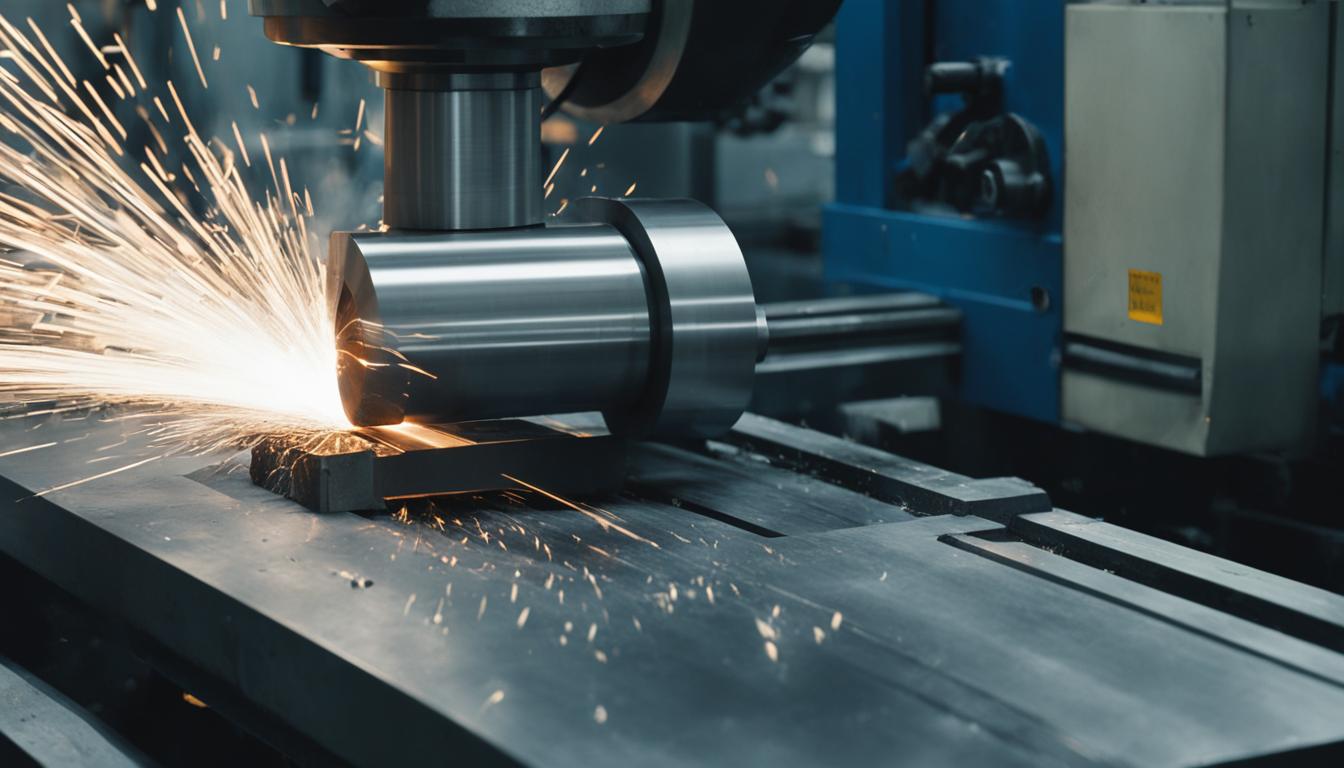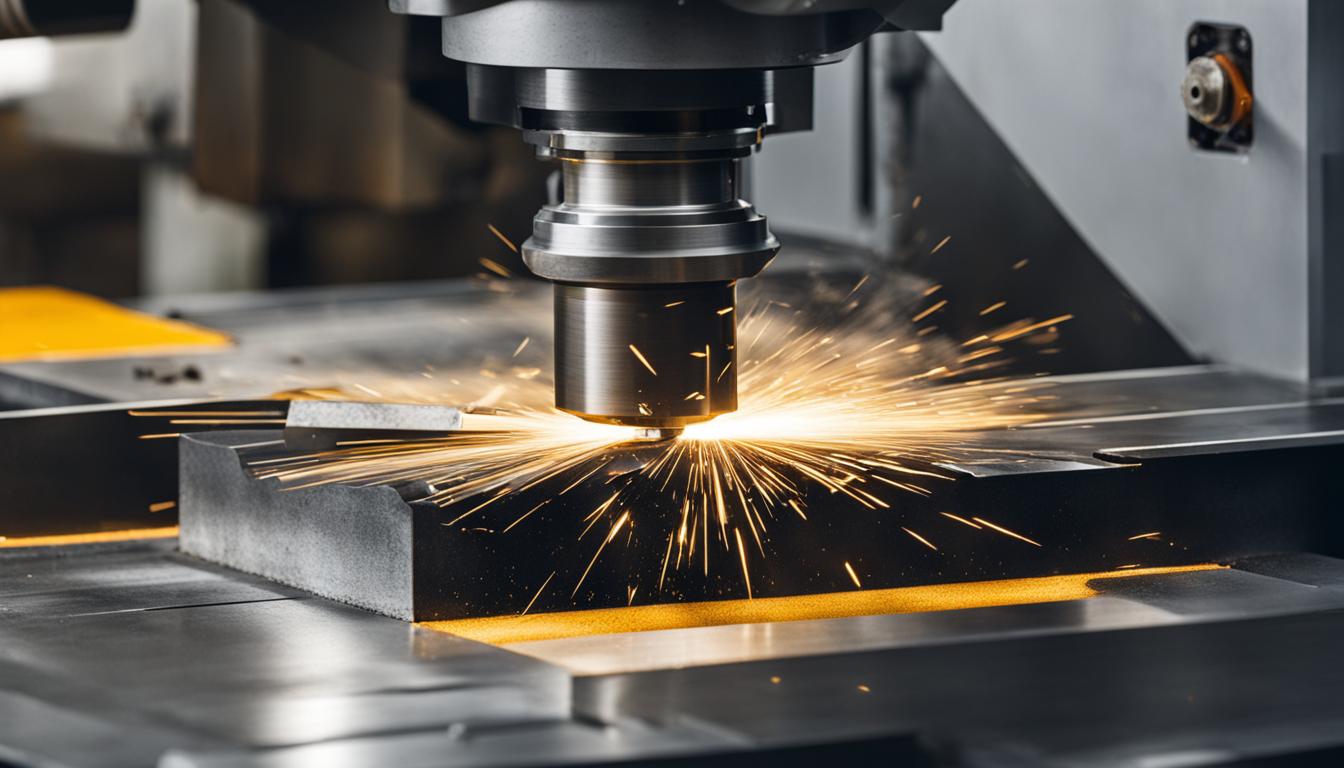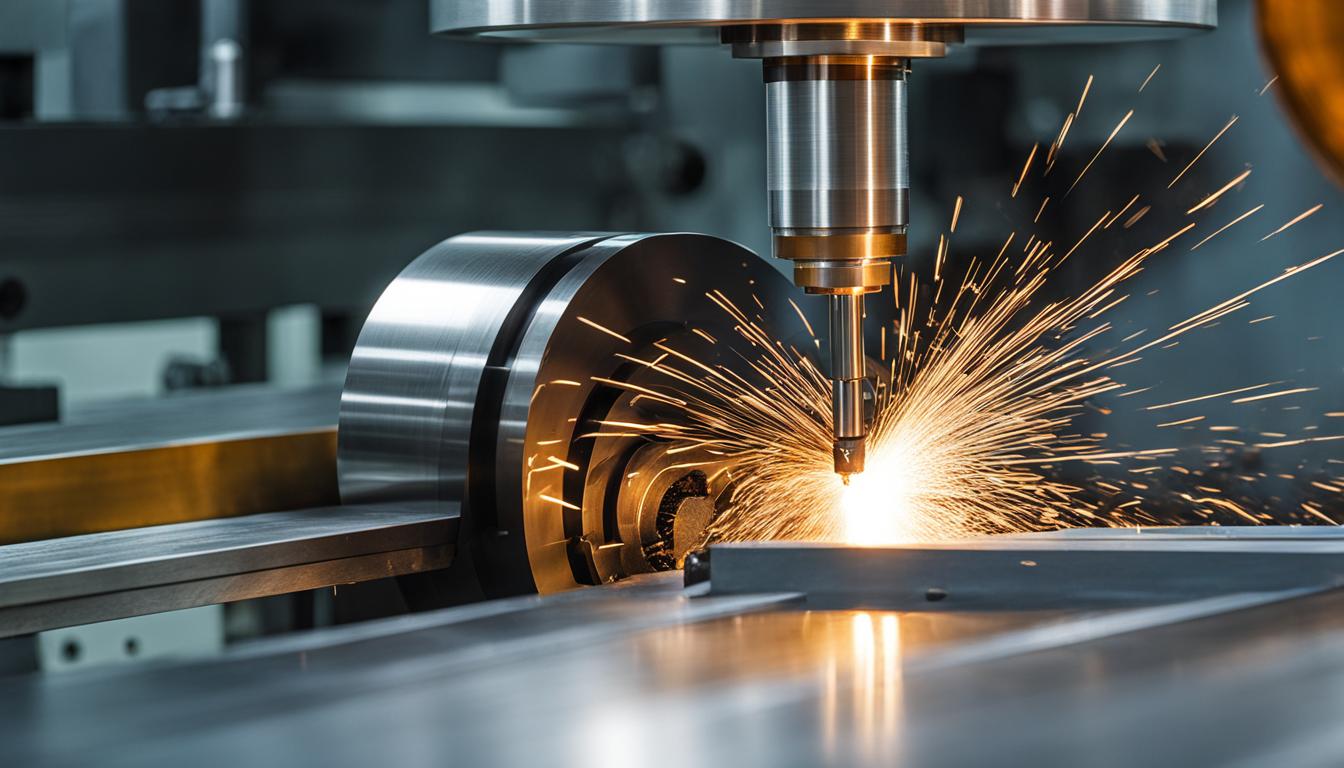CNC milling is a widely used machining process in the metalworking industry. It offers high precision and efficiency, making it a preferred choice for manufacturers. Understanding the different milling techniques is crucial in determining the best method for specific applications. Let’s explore some of the popular CNC milling techniques and their advantages.
Key Takeaways:
- CNC milling is a computer-controlled machining process known for its accuracy and efficiency.
- Milling techniques include surface milling, face milling, angular milling, form milling, and profile milling.
- Surface milling is ideal for quick material removal, while face milling achieves precise and smooth surfaces.
- Angular milling is used for angled cuts and grooves, while form milling creates curves and radii.
- Profile milling is perfect for concave or convex designs and achieving precise profiles.
What is CNC Milling and How Does It Work?
CNC milling is a machining process that utilizes computer-controlled rotary cutting tools to remove material from a workpiece. Unlike traditional machining methods, CNC milling is precise, efficient, and capable of producing complex shapes. The process begins with a computer-aided design (CAD) or a 3D model of the component.
Once the design is ready, it is translated into machine-readable instructions that guide the CNC mill. These instructions outline the specific movements and operations required to shape the workpiece according to the design. The CNC mill uses computer-controlled cutting tools to remove material and create the desired shape.
With the ability to accurately control the cutting tools, CNC milling offers several advantages. It allows for intricate details, tight tolerances, and consistent results. The computer-controlled nature of the process ensures precision and repeatability, making CNC milling a preferred choice for various industries and applications.
Whether it’s creating prototypes, manufacturing complex parts, or producing customized components, CNC milling provides a versatile and efficient solution. By leveraging computer-controlled cutting tools, manufacturers can achieve precise and high-quality results while optimizing productivity.
Surface or Plain Milling Technique
Surface or plain milling is a popular technique used in CNC milling. It is an effective method for removing material from the surface of the workpiece to achieve the desired shape or finish. This technique involves using various tools and cutters to carefully remove layers of material, resulting in a precise outcome.
The surface milling process is performed with the mill’s rotation axis moving parallel to the workpiece. The type of cutter used depends on the desired outcome, whether it is quick material removal or a finer finish. For example, a wide cutter can be employed for fast material removal, while a tool with finer teeth is recommended for achieving a smoother finish.
To ensure optimal results, the cutting speeds and feed rates can be adjusted according to the specific requirements of the project. This allows manufacturers to customize the surface milling technique to achieve the desired level of material removal and finish.
Surface milling is widely used in various industries, including automotive, aerospace, and manufacturing. It offers the advantage of precise and controlled material removal, making it an essential process in achieving high-quality results.
Implementing the surface milling technique in CNC milling operations requires skilled operators and appropriate machinery. By utilizing this technique, manufacturers can efficiently and effectively shape and finish their workpieces to meet the desired specifications.
Face Milling Technique
Face milling is a fundamental technique in CNC milling that involves removing material from the surface of a workpiece. This technique is particularly useful for achieving precise and smooth surfaces, making it a popular choice for applications that require intricate contours and fine finishes.
One of the key aspects of face milling is the orientation of the machine’s rotational axis. In this technique, the rotational axis is perpendicular to the surface of the workpiece. This positioning allows the cutting tool to face the workpiece face down, making it easier to remove material from the surface.
Different types of cutters can be used in face milling to achieve specific results. For example, dovetail cutters are ideal for creating angled grooves, while conical cutting heads are effective for chamfering. The choice of cutter depends on the desired outcome and the specific requirements of the project.
Face milling is essential for achieving precise surface finishes and removing material from the workpiece efficiently. Its versatility and accuracy make it a valuable technique in industries such as automotive, aerospace, and manufacturing.
By utilizing the face milling technique, manufacturers can achieve remarkable surface finishing and dimensional accuracy on a wide range of materials. This technique plays a significant role in ensuring the final product meets the required specifications, quality standards, and customer expectations.
Angular Milling Technique
Angular milling is a versatile technique used in CNC milling to achieve angled cuts and create grooves on the surface of a workpiece. In this method, the cutting tool faces the workpiece’s surface at an angle, allowing for precise machining of designs with angular features, such as dovetails or grooves.
To perform angular milling, different types of cutting tools can be used, depending on the desired results. For example, dovetail cutters are commonly employed to create dovetail-shaped grooves, while conical cutting heads are ideal for machining designs that require angled cuts.
This technique offers manufacturers the flexibility to produce various angled cuts and contours, enabling the creation of intricate and customized components. Whether it’s for precision engineering or artistic designs, angular milling provides the necessary precision and versatility.
Advantages of Angular Milling
Angular milling offers several advantages, making it a valuable technique in the CNC machining industry:
- Ability to create complex shapes with angular cuts: Angular milling enables manufacturers to produce intricate designs with angled cuts, enhancing the aesthetic appeal and functionality of the final product.
- Precision and accuracy: By carefully controlling the angle and depth of the cutting tool, angular milling ensures precise and accurate cuts, resulting in high-quality components.
- Versatility: This technique is suitable for various applications, including aerospace, automotive, and tooling industries, where precise angled cuts and grooves are required.
- Efficiency: Angular milling allows for the simultaneous removal of material and creation of angled features, reducing production time and increasing productivity.
Applications of Angular Milling
The angular milling technique finds applications in a wide range of industries, where the creation of angled cuts and grooves is essential. Some common applications include:
- Machining dovetail joints in woodworking and carpentry.
- Creating angled slots for sliding mechanisms in machinery.
- Machining angled grooves for O-rings in seal manufacturing.
- Producing custom angled surfaces for artistic sculptures and decorative components.
| Advantages | Applications |
|---|---|
| Precision and accuracy | Machining dovetail joints in woodworking and carpentry |
| Ability to create complex shapes with angular cuts | Creating angled slots for sliding mechanisms in machinery |
| Versatility | Machining angled grooves for O-rings in seal manufacturing |
| Efficiency | Producing custom angled surfaces for artistic sculptures and decorative components |
Form Milling Technique
Form milling is a versatile technique used for creating radii, counters, and curves in a workpiece. By using different cutting tools, manufacturers can achieve precise and accurate results for each detail in the design. Form milling offers the advantage of allowing non-flat cuts to be made in a single session, saving time and eliminating the need to switch between cutting heads.
When employing form milling, selecting the appropriate cutting tools is crucial in achieving the desired outcome. Whether it’s creating round edges or recesses, the right tools will ensure accuracy and efficiency. Form milling is a preferred technique for creating intricate shapes and profiles, particularly in industries such as automotive, aerospace, and mold making.
Form milling enables manufacturers to add complexity and aesthetic appeal to their workpieces. By utilizing cutting tools that are specifically designed for shaping radii, creating counters, and forming curves, manufacturers can achieve high-quality results in a single operation. This reduces production time and costs while maintaining the desired level of precision.
With form milling, manufacturers have the flexibility to create intricate designs and contours that cannot be achieved through other machining techniques. This technique opens up new possibilities for innovative product designs and improves the overall quality of the final workpiece.
Profile Milling Technique
Profile milling is a versatile machining technique used to achieve concave or convex designs in a workpiece. This technique involves a three-step process consisting of roughing, half-finishing, and final finishing. By following these steps, manufacturers can create precise profiles and contours that meet their specifications.
During the roughing stage, round inserts are used to remove the bulk of the material and shape the workpiece according to the desired design. This initial roughing helps to establish the overall shape and size of the concave or convex profile.
Next, the half-finishing stage involves using ball-nose end mills to refine the profile. These tools have a rounded tip that allows for more intricate and precise machining. The half-finishing process helps to smooth out any imperfections and enhance the accuracy of the profile.
Finally, the workpiece undergoes the final finishing stage, where ball-nose end mills are used again to achieve a smooth and polished surface finish. This step ensures that the profile meets the specified requirements and provides a high-quality end result.
Profile milling is particularly beneficial for applications that involve concave or convex surfaces and curved edges. It offers flexibility in creating complex designs with precise details and contours. This technique is commonly used in industries such as automotive, aerospace, and mold and die manufacturing.
By leveraging profile milling, manufacturers can achieve superior surface finishes, maintain dimensional accuracy, and meet the demands of their design specifications. It is a valuable technique in the realm of CNC milling, offering endless possibilities for creating intricate and visually appealing profiles.

Key Advantages of Profile Milling Technique:
- Ability to create concave and convex designs with precision
- Three-step process for roughing, half-finishing, and final finishing
- Utilization of round inserts and ball-nose end mills
- Excellent for achieving smooth surface finishes
- Ideal for machining curved edges
- Wide range of applications, including automotive, aerospace, and mold and die manufacturing
Choosing Between Face Milling and Peripheral Milling Techniques
When it comes to selecting the right milling technique, it is essential to consider the specific machining requirements. Face milling and peripheral milling are two commonly used techniques, each with its own advantages and applications.
Face milling is an ideal choice for creating flat and smooth surfaces. This technique involves removing material from the top surface of the workpiece, ensuring a consistent and even finish. Face milling is particularly effective for shallow cuts and achieving precise surface finishes.
On the other hand, peripheral milling excels at removing material from the edges of the workpiece. This technique allows for deep cuts and quick material removal, making it suitable for applications where efficient material removal is crucial.
When deciding between face milling and peripheral milling, the choice should be based on the desired surface finish and the amount of material that needs to be removed. If the goal is to achieve flat and smooth surfaces, face milling is the preferred technique. However, if quick material removal is the priority, peripheral milling is the better option.
To further illustrate the differences between face milling and peripheral milling, refer to the table below:
| Aspect | Face Milling | Peripheral Milling |
|---|---|---|
| Cutting Depth | Shallow cuts | Deep cuts |
| Surface Finish | Precise and smooth | Less uniform |
| Material Removal | Slower | Efficient |
This table highlights the key differences between face milling and peripheral milling in terms of cutting depth, surface finish, and material removal.
In conclusion, face milling and peripheral milling techniques offer distinct advantages depending on the machining requirements. By understanding the differences between these techniques and considering factors such as cutting depth, surface finish, and material removal, manufacturers can make an informed decision when choosing the most suitable milling technique for their specific needs.
Purpose and Applications of Face and Peripheral Milling
Face milling and peripheral milling are two important techniques in CNC milling with distinct purposes and applications. Understanding their specific uses can help manufacturers choose the right milling method for their machining needs.
Face Milling
Face milling is primarily used to create flat surfaces and achieve smooth finishes. It involves removing material from the workpiece’s face using a cutter with multiple teeth. This technique is commonly used in applications that require precise and flat surfaces, such as plates or bars. The surface finish achieved through face milling is often of high quality and uniform across the workpiece.
Peripheral Milling
Peripheral milling, on the other hand, focuses on machining the edges of a workpiece, creating contoured or profiled edges. In this technique, the cutter engages the workpiece peripherally, removing material from the periphery instead of the face. Peripheral milling is versatile and finds application in various machining operations:
- Slabbing Operations: For removing a large amount of material from a broad surface
- Profile Milling: For creating intricate profiles and complex contours
- Slotting: For cutting slots or grooves into workpieces
- Straddle Milling: For machining parallel surfaces on both sides of the workpiece
- Slitting Operations: For cutting thin strips or slits in the material
- Rough Machining: For quickly removing large material volumes at higher cutting depths
Peripheral milling is a versatile technique widely used across industries to shape and refine the edges of workpieces, creating the desired contours and profiles.

Differences Between Face Milling and Peripheral Milling Techniques
Face milling and peripheral milling techniques differ in several key aspects, including tool engagement and surface finish. When it comes to tool engagement, face milling involves full-width contact between the cutting tool and the workpiece. This results in a more uniform and smoother surface finish compared to peripheral milling.
On the other hand, peripheral milling has partial-width engagement, meaning that the cutting tool only engages with the workpiece on the outer edges. As a result, the surface finish achieved through peripheral milling may not be as even or uniform as that obtained through face milling.
Another distinguishing factor between the two techniques is the cutting depth. Face milling is typically used for shallower cuts, where the main goal is achieving a smooth and precise surface finish. In contrast, peripheral milling is often employed for deeper cuts and efficient material removal, making it suitable for applications where quick material removal is necessary.
When choosing between face milling and peripheral milling techniques, manufacturers should consider both the desired surface finish and the cutting depth required for the specific machining task at hand. By understanding the differences between these techniques, manufacturers can make informed decisions about which method to employ to achieve optimal results.
